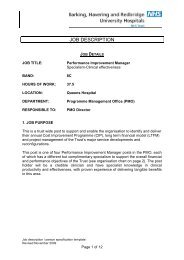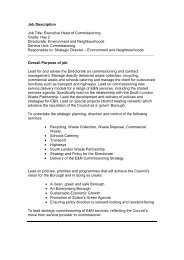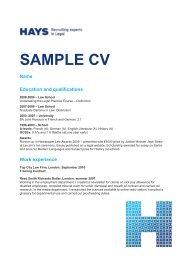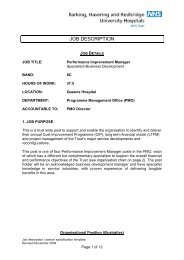ICT Strategy 2013 - Hays
ICT Strategy 2013 - Hays
ICT Strategy 2013 - Hays
You also want an ePaper? Increase the reach of your titles
YUMPU automatically turns print PDFs into web optimized ePapers that Google loves.
3.1 Architectural Principles<br />
The following set of Architectural Principles, which will govern the design and provisioning of the<br />
Council’s <strong>ICT</strong> services, are summarised in the following table. There is no set priority contained<br />
within these principles with the relative priority of each considered on a case by case basis.<br />
Ref Architecture Principle Explanation<br />
1 Generic capabilities in<br />
systems where possible,<br />
versus bespoke systems<br />
2 Control technical diversity<br />
and consolidate<br />
The Council will pursue a strategy of configuring fit-for-purpose<br />
packaged software rather than bespoke software development,<br />
and wherever possible encourage the use of “vanilla” products<br />
with minimal local customisation.<br />
The Council will seek to minimise and standardise the portfolio<br />
of technology implemented across the business. We will seek to<br />
consolidate technology so that multiple solutions share core<br />
infrastructure appropriately. We will capitalise on<br />
organisational-wide licensing benefits and remove multiple<br />
versions of the same software whenever possible. We will also<br />
seek to ensure that all projects embed decommissioning<br />
activities as part of project deliverables and cost.<br />
3 Prioritise supportability The Council will procure and implement solutions that inherently<br />
consider the whole life support skills and resources required so<br />
that service delivery can be maintained and ensure projects<br />
embed IT and business staff training as part of project<br />
deliverables and cost. We will ensure that projects consider the<br />
on-going support requirements as part of their decision making<br />
processes, and ensure the resources to deliver these are<br />
identified.<br />
4 Design common use<br />
solutions that promote<br />
reuse of business<br />
functionality<br />
5 Maximise existing and<br />
future <strong>ICT</strong> investment<br />
6 Embed appropriate<br />
Disaster Recovery and<br />
Business Continuity<br />
provision<br />
7 Ensure availability of <strong>ICT</strong><br />
Services<br />
The Council will seek to provide generic <strong>ICT</strong> capabilities available<br />
to the whole organisation that can be repurposed to deliver<br />
specific solutions for individual service areas. Where<br />
appropriate we will also enable the reuse of standard business<br />
process and functionality.<br />
<strong>ICT</strong> provisioning decisions will control cost of ownership and<br />
support business needs whilst balancing cost, functionality, risk<br />
and benefits. This includes reuse of existing applications,<br />
infrastructure and skills/capabilities within the business and with<br />
our partners. This principle will not impose unacceptable<br />
limitations on transformation, and the enterprise architecture<br />
will govern the introduction of technology according to actual<br />
business need.<br />
Solutions and infrastructure will be selected, configured and<br />
deployed in such a way that the business is protected from<br />
individual component failures according to prioritised risk and<br />
impact assessments. We will ensure appropriate contingencies<br />
and reduce risk for when serious failures occur.<br />
Solutions and infrastructure will be designed to meet the<br />
required levels of availability of the business. This may include<br />
special provision at key times to support periodic fluctuations in<br />
demand for the service area.<br />
South Gloucestershire Council Business <strong>ICT</strong> <strong>Strategy</strong> <strong>2013</strong>-2016 Page 16 of 30
















